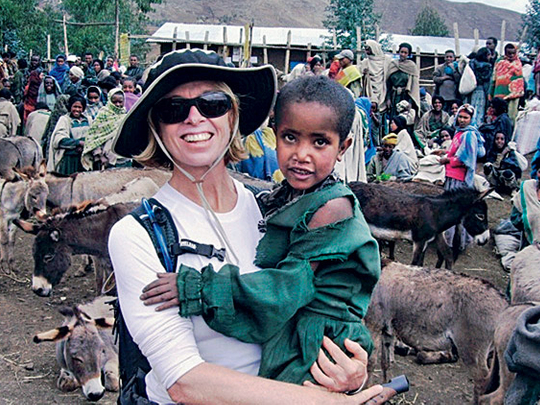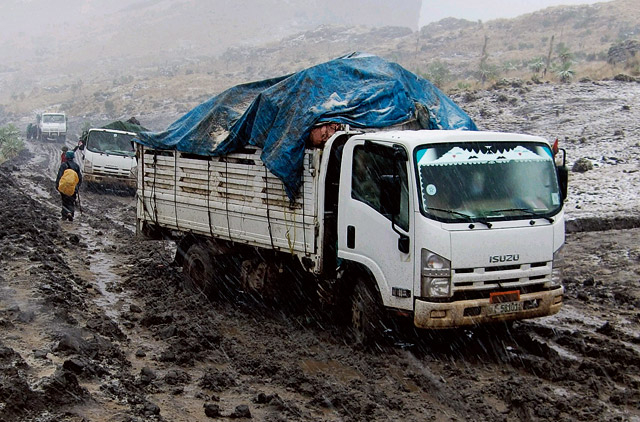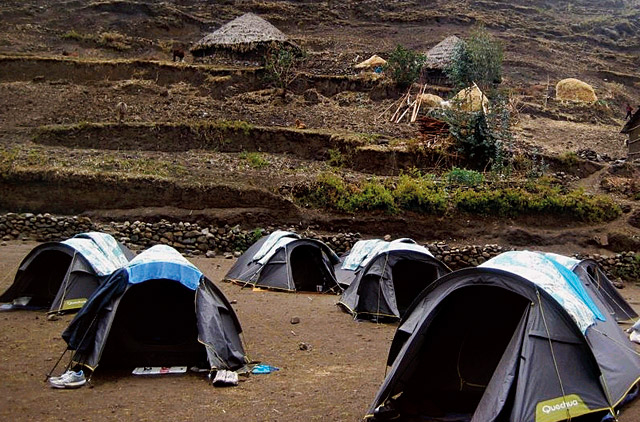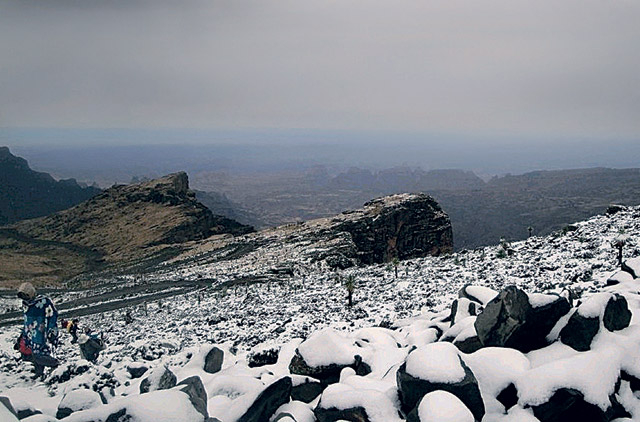
You could say I have unfinished business in Africa. Years ago I worked as a journalist in East Africa and I have been witness to the horror of famine and war. My Dubai life of luxury has at times felt somewhat unjust in comparison. It took little persuasion, then, for me to sign up to Gulf for Good's Trek Ethiopia, a challenge that involved walking 120 kilometres over six days at high altitude through the Simien Mountains, summiting Africa's fourth highest peak, Ras Dashen, 4,620 meters high. By completing the trek I would raise enough money to transform a small community project in Addis Ababa.
The challenge begins
One of the two things needed to prepare for the challenge was physical fitness. As an avid runner and self-confessed gym junkie, that was the easy part. Gulf for Good graded the trek ‘demanding' on their difficulty scale - meaning it required excellent fitness levels. To support challengers Gulf for Good hosted a minimum of two weekly training sessions; the perfect opportunity to meet fellow trekkers and increase fitness levels. The sessions were a combination of hotel stair-climbing, long treks and beach circuit training.
Coming up with the required Dh18,000 in sponsorship was the hard part. I figured that something to benefit kids should involve kids, so in February my son's rugby team, a group of dedicated and passionate 9 and 10-year olds, ran the 72-kilometer relay race through Wadi Bih near Dibba. Never attempted before by a team so young, the boys finished the race in six hours and 50 minutes. As they crossed the finish line singing Queen's ‘We are the Champions' there wasn't a dry eye amongst us. For their efforts the boys raised a whopping Dh20,000 for the children of Ethiopia. The hard part was over, or so I thought.
Day One: Dubai - Addis Ababa
Leaving my husband and two children felt like leaving an arm behind. But with their support and encouragement, I joined the rest of the 19 members of the Gulf for Good team. We were a group of mostly strangers with three thing in common - a sense of adventure, a sense of social responsibility and a sense of humour. Representing ten different countries, for many this challenge was immense. Some had never slept in a tent; some had never trekked before. For others, the veterans we all looked up to, this was the third, fifth, or even ninth Gulf for Good challenge. We boarded the plane headed for Addis Ababa. As strangers we were slightly guarded, polite and civil to one another. After ten intense days together the connections we made and shared was beyond friendship, equal instead to that of close family members. Mother to us all was Gulf for Good leader, P, who personally guided and reassured each one of us through the gruelling week ahead.
Once in Addis I was assigned my tent partner, a former model turned yoga guru from California. Jenny and I bonded instantly, her giggles, crucial stretches and essential oils from that moment earned her best friend status. We enjoyed our last night of comfort, tucked between crunchy-clean hotel sheets, trying to snooze away the gnawing feeling of trepidation.
Day Two: Addis-Gondar-Debark-Sankabar (3,230m)
From Addis we flew 750 kilometers north to Gondar, the country's once splendid capital. Nicknamed the Camelot of Africa, Gondar's now derelict castles (and the odd burnt out tank) bare the scars of Ethiopia's civil war. We boarded a bus and began the 120km journey to Debark, entrance to the UNESCO-protected Simien National Park.
The tarmac stopped about when the rain started. We bumped and jiggled our way over collapsed roads and splashed through yawning potholes. The harder the rain fell, the more the dust turned to mud and the more our bus skidded and squelched up the track. Inevitably we got completely stuck. We were towed to safety by a handy bulldozer and a handful of sniggering road-workers. We reckoned one of them was no more than eight years old. It had taken us two hours to travel 14 kilometers.
Sankabar - six jarring, eternal hours later - was a bleak misty field inside the national park. We slurped what was to become our nightly staple - soup followed by rice or pasta with a spicy tomato sauce. To get warm Jenny and I curled into our small cocoon tents that slept two snugly. On a thin foam mattress with a rock in my back and my bones still rattling I fell into a restless sleep.
Day Three: Sankabar (3,230m) - Geech (3,580m), 5 hrs, 15km
Our campsite, one of the lower points of the Simien Mountain range, sat at a lung-screaming height of 3,230 meters above sea level. The country uses the ancient Coptic calendar, which means that although it was March 12, 2011, it was actually only March 3, 2003 in Ethiopia. The time we were woken was 6am, which according to the Ethiopian clock is the equivalent of midnight. It seemed a lot to deal with on thin air.
After our standard steaming oatmeal breakfast the rain eased and through the clearing mist we were treated to glimpses of green hills rolling into cavernous, bottomless drops. As we walked we spotted narrow waterfalls that collapsed thousands of meters below us. It was tough, but satisfying walking and the landscape slowly changed from lush green shrubbery to parched, cracked yellow tussock. Following our local guide - under the protection of three armed guards - we carried all we needed for the day. An army of donkeys followed loaded up with our bags, food, tents and increasingly sodden mattresses.
As evening fell we staggered up through the clouds to the village of Geech. The hills were a misty blue. The sound of dogs barking, roosters crowing and children yelling, carried for miles through the mountain air. The wind howled and the temperature dropped precipitously. The cook, with a live chicken flung over his shoulder disappeared unceremoniously clutching a knife. That was dinner.
Day Four: Geech (3,580m) - summit Imet Gogo (3,986m) - Geech, 5 hrs, 12 kms
Night brought with it perishing cold. I slept fitfully, my head pounding and my heart racing to the point of nausea. Recognising these as the symptoms of altitude sickness, I resigned myself to taking medication to alleviate the effects of high elevation. Of our group of 20, over half were by now suffering the same. By the end of the next day three had to abandon the challenge and go back to Addis.
Today's trek took us through barren alpine tussock with families of indigenous Gelada baboons rummaging in the grass in front of us. A scramble at the end had us up Imet Gogo where the ground dropped away into a dramatic vista of depth and wonder. Sculpted by 40 million years of eruptions and erosion, the Simiens are fondly dubbed the ‘chess pieces of the Gods'. What lay below us was a haunting mix of sheer escarpments, jagged cliffs, deep gorges, and stone columns. No wonder Ethiopians claim this as the roof of the world.
On the trek back down to camp the clouds once again darkened. Torrential rain turned to hail with stones the size of the frozen goat droppings we crunched across. We sheltered in a nearby mud and grass farmhouse, picking our way between goats and chickens to huddle, steaming, around the smoky fire. We were invited for coffee, an hour-long ritual that involved roasting coffee beans, grinding, then brewing them into a thick, deliciously bitter drink. We were also offered Ethiopia's staple ‘injera', a spongy pancake made from teff flour that has the consistency of a thin slice of cold, moist foam rubber. Topped with a fiery chili sauce, I was assured it's an acquired taste. Walking back to our tent on a carpet of still frozen hailstones we were followed by grinning barefoot children. My feet burned with privilege in my gortex boots.
Day Six: Chenek (3,620m) - Bwait Pass (4,430m) - Ambiquo (3,200m), 9 hrs, 26kms
The previous day we hiked for eight hours to Chenek. From there it was another nine-hour walk up over the Bwait Pass then back down the other side to the village of Ambiquo at the foot of the Ras Dashen summit. We stopped for lunch in the bustling village of Mesheba. It was market day and donkeys lined the sweet-smelling avenues of eucalyptus. A shrouded corpse was carried nonchalantly by on a goatskin stretcher. We were the only ones flinching; when the age expectancy is a mere 45 years, death is an everyday part of life.
Day Seven: Summit Day: Ambiquo - Ras Dashen (4,620m) - Ambiquo, 13 hrs, 20kms
4am, our intended time of departure, we woke to torrential rain. By the time we set off daylight shone weakly through the easing rain. What followed was a long hard slog uphill through snow and ice. The higher we went the more lightheaded I became and the more my chest felt like exploding for lack of air. Over 4,200 meters walking becomes difficult, making the seven-hour trek up more of a shuffle. A break to attempt a few bites of trail mix and a lung-full of oxygen left me frozen within minutes. There was nothing for it but to soldier on, the great grey peak looming ever closer.
The last 200 meters we abandoned packs and started the final climb, clinging on to icy rocks with our fingernails, giddy on thin air and adrenaline. For anyone with a heartbeat, the view atop that panoramic precipice overlooking the Abyssinian abyss is enough to take your breath away.
The biting wind had us down before the euphoria could sink in. We were faced with the hobble back down the mountain for five long hours in the deafening silence of falling snow and contemplation. By now our backs, feet and legs were singing with fatigue. Turning the corner to reach camp - thirteen hours and an eternity since we began - we heard singing. The entire village had come out to welcome us back from the peak. As I was presented with cheers, smiles and a bunch of wild flowers, the enormity of our achievement finally hit. Tears of exhaustion, relief and the overwhelming sense of accomplishment fell uncontrollably.
Day Eight: Ambiquo (3,200m) - Bwait Pass (4,430m) - Chenek (3,620m), 9 hrs, 26km
The ‘sting in the tail' day, this tested even the most determined amongst us. The summit was over, our bodies ached, but we still had a nine-hour, kilo meter high, snow challenged climb back over Bwait Mountain. Teeth gritted, the smell of home, a few mules for the injured, the promise of a shower and our camaraderie got us all back safely.
Day Ten: Addis Ababa, RAEY Child and Family Development Project
As a group we had managed to raise US$60,000 for RAEY, a community development centre in Addis Ababa that offers education, health, nutrition and nurturing to children aged three to nine years living with HIV/Aids and their families. The school has 112 students with over 7,000 on a waitlist. Only the most destitute are admitted. Many have lost one or both parents to HIV/Aids and all live with disease and extreme poverty. For most of us, the pinnacle of Trek Ethiopia was not the peak but our day with these children. We fitted their new shoes, distributed new pencils, fed them lunch and bathed in their gratitude. It was incredibly humbling how, with relatively little effort, we had literally transformed the lives of not just the children we came to know but also their guardian families.
Back home
Now, back in Dubai, I have blistered lips, two black toenails, 21 fleabites and still-aching muscles. I've never felt more radiant. Trek Ethiopia was the ultimate challenge; the discovery of a land forgotten by time, connections with new life-long friends and a personal journey that pushed my physical and mental limits. The ultimate satisfaction lies in knowing I have single-handedly contributed to the education of over 100 Ethiopian children. What a week.
Gulf for Good is a not-for-profit charity that organises exciting adventure challenges around the world. Participants raise funds to be donated to handpicked charities in the region. For more on upcoming challenges visit www.gulf4good.org.
For more information on RAEY child and Family Development Association in Addis Ababa, to learn ways to help or donate visit www.raey.org.






